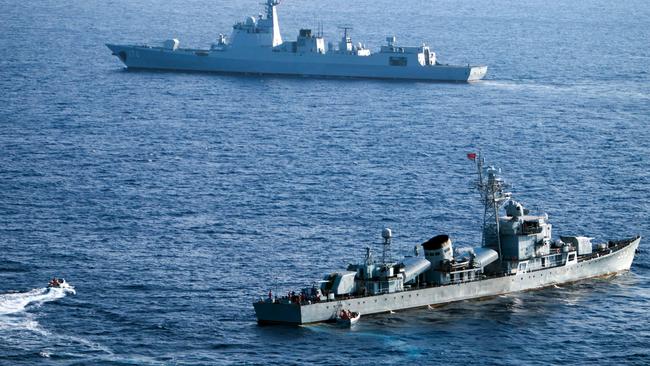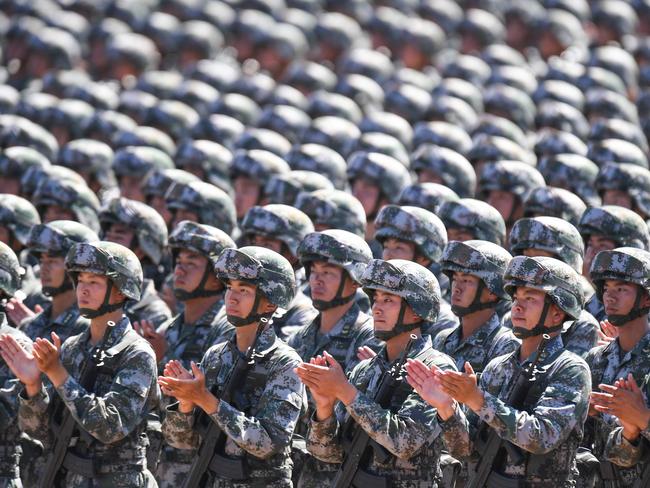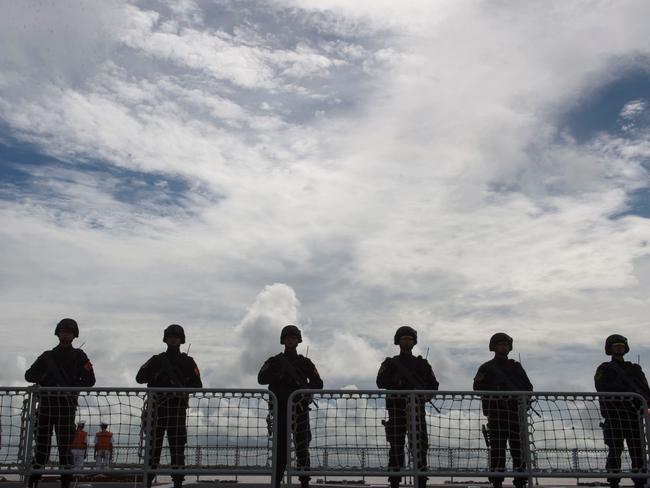China expansion in South China Sea: Can it beat the US without a war?
NORTH Korea isn’t the biggest issue facing the US right now, military sources claim. Another player is vying for dominance.

CHINA remains the most pressing threat to the Pacific today and the country is on a path to win without a fight, United States military officials have revealed.
Speaking to US broadcaster NBC News, the unnamed officials said the threat of North Korea was less of a concern because “it’s a fight we could win.”
However China represents a less certain outcome.
“PRC (People’s Republic of China) is the most pressing threat in the Pacific,” one official told the broadcaster.
The military officials also warned China’s ultimate goal was to be the dominant player in the region with the Asian powerhouse already making changes to international order.
“China is on a path to win without a fight,” an official said.
Beijing has “changed the rules” in recent years with man-made islands and installations springing up across the South China Sea “hundreds of miles from the mainland”.
According to NBC, the officials claim islands such as Fiery Cross and Woody Island offer the Chinese a platform close enough to attack all US operational bases in the region.
Beijing was also using a strategy known as hybrid warfare where China’s military uses fishing boats assigned to commanders to hassle other vessels.
While acknowledging the threat of war between Beijing and Washington remained low, the officials claim the risk of miscalculation remains high.


DOMINANT PLAYER
According to Dr Malcolm Davis, a senior analyst in defence strategy and capability at the Australian Strategic Policy Institute, China’s growing ambitions are obvious.
He said it uses a mix of soft and hard power to achieve its ambitions and aims.
“China’s approach is to use military power in ‘grey zone’ actions — at a level short of war to gradually reshape the status quo to meet its national security goals and strategic ambitions,” Dr Davis said.
“They seek to dominate Asia at the expense of the US, by a combination of hybrid military actions in areas such as the South China Sea (for example threats) combined with soft power such as the Belt and Road Initiative (or inducements).”
China’s used both threats and inducement to shape the region which enabled them to “win without fighting” over the long term.
Dr Davis said it was clear China’s goal was to challenge and revise the established rules-based international order, replacing a US-led model with a Chinese-led one.
Referring to Chinese President Xi Jinping’s time frame for the country to become a “global leader” with international influence within the next 30 years, Dr Davis said it was clear what Beijing’s intentions were.
“Xi made that very clear in his 3 ½ hour speech at the 19th Party Congress,” he said.
“What they seek is to establish a Chinese-led economic, political and security order in Asia, that excludes the US, weakens or ends US strategic primacy, and supplants it with Chinese dominance.”

Mr Xi also seeked a rejuvenated China as a global power restored to what Chinese consider to be their rightful place at the centre.
Dr Davis said the use of Military power was another tool to achieve if used carefully and in a calibrated manner, “like a scalpel, rather than crudely like a bludgeon”.
“If they can use this combination of threat and inducement (costs versus rewards) they hope to reduce US influence and presence and see more Asian states, particularly in Southeast Asia, realign with China,” he said.
RULING AMBITIONS
Growing speculation surrounding China’s ambitions were heightened after last month’s 19th Party Congress in Beijing.
In his speech, Mr Xi urged a reinvigorated Communist Party to take a stronger role in society and economic development to better address the nation’s “grim” challenges.
Speaking in the massive Great Hall of the People near Tiananmen Square, Mr Xi laid out his vision of a ruling party and hailed the start of a “new era”, outlining a vision in which the party would lead China on the road to becoming a “great modern socialist country” by the mid-century”.
Mr Xi hailed his country’s island-building efforts in the disputed South China Sea as well as his signature foreign-policy initiative, the One Belt, One Road infrastructure investment project.
China has raised eyebrows in recent months following the construction of several man-made islands and an underwater spying station.

In July, Beijing announced it was building an underwater observation system across the disputed East and South China seas.
State broadcaster CCTV announced the “networks will also serve as a platform to provide long-term observation data and support experiments in the research of the maritime environments of the two seas.”
However the $400 million project sparked some concerns that it could be used detect the movement of foreign ships and feed information back to China.
Earlier in April, China’s mysterious building project drew the ire of the US after new satellite photos emerged.
A US report warned China has almost completed construction of three mysterious man-made islands.
The strategic bases will give Beijing the ability to deploy combat aircraft and other military assets efficiently across areas in the disputed South China Sea.
The Washington-based Center for Strategic and International Studies (CSIS) analysed recent satellite photos which showed China was using its island-building project to give teeth to its claim over almost the entire South China Sea and its islands and reefs.



